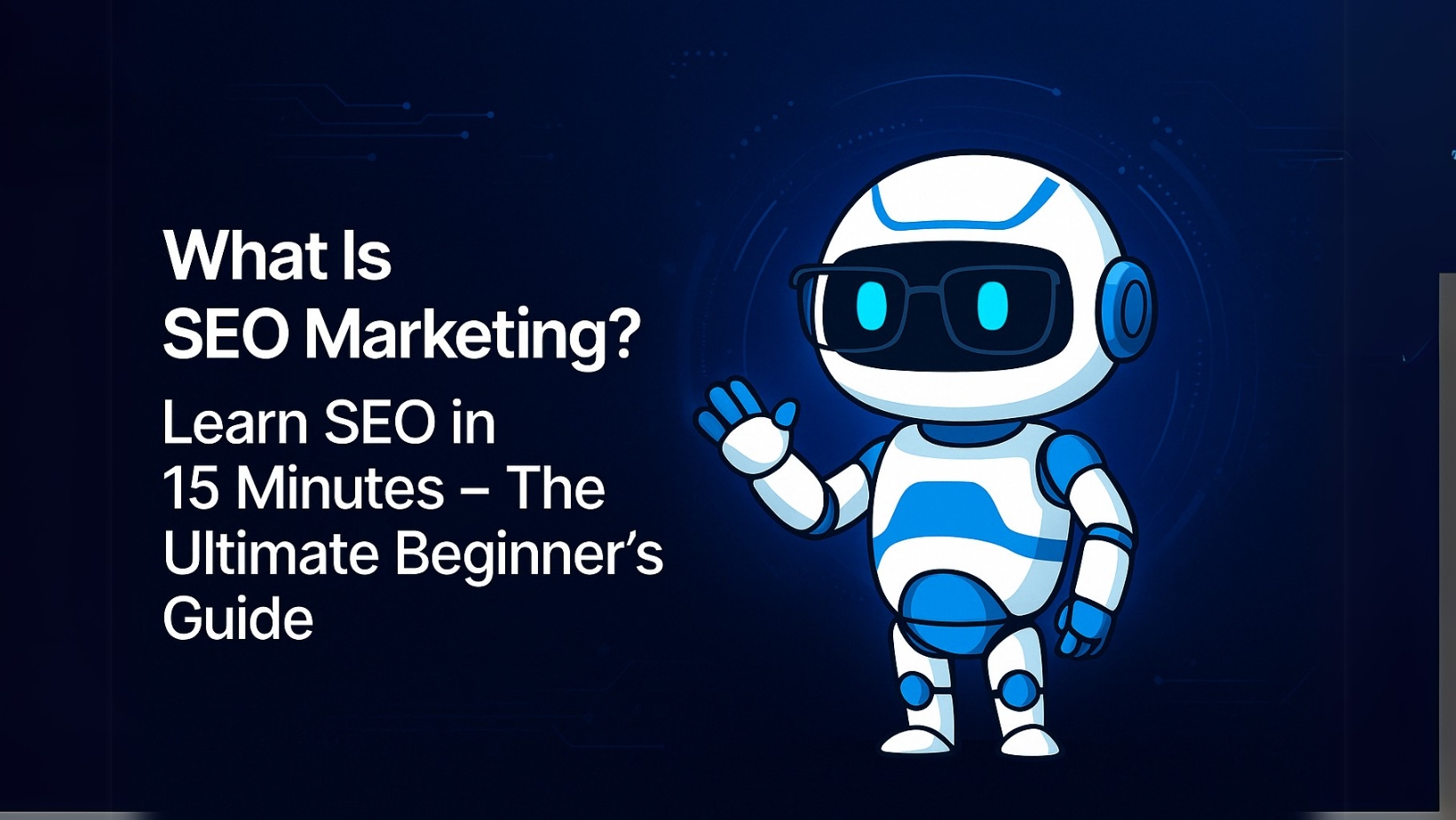
In today’s digital world, search engines are often the first place people go to find answers, solutions, and businesses. If your website isn’t showing up in those search results, you’re losing potential customers to competitors who areama.org.
That’s where SEO marketing comes in. What is SEO marketing? Simply put, SEO stands for Search Engine Optimization – it’s a digital marketing strategy focused on improving your website’s visibility on search engines like Google or Bing organically (without paying for ads).
By learning the basics of SEO marketing, you can make your site easier to find and attract more visitors. This guide will walk you through what SEO marketing is, why it matters, the different types (on-page, off-page, technical, local SEO), how it works, and some easy tips and tools to get you started. Let’s dive in!
What Is SEO Marketing?
SEO marketing (search engine optimization) is the process of optimizing your website so that it ranks higher in search engine results pages (SERPs), making it easier for your target audience to find you when they search for relevant terms.
In essence, SEO marketing is about helping search engines understand your content and trust your site, so they deliver your webpages to users looking for information, products, or services like yours. The higher your pages rank for important keywords, the more organic (unpaid) traffic you’ll get, which can lead to more leads, customers, and sales.
According to an industry guide by Search Engine Land, SEO helps search engines connect your website’s content with users’ queries by delivering relevant, valuable results. In practical terms, that means tweaking various aspects of your site so that search engines deem it high-quality and relevant for specific searches.
The goal of SEO marketing is to land on the first page of search results for keywords your audience uses, because about 69% of clicks go to the top 5 organic results – appearing on page two or beyond dramatically reduces your visibility.
SEO marketing is a core part of digital marketing. It differs from paid search advertising in that you don’t pay search engines for placement. Unlike Pay-Per-Click (PPC) ads, which stop generating traffic once you stop paying, SEO focuses on earning traffic naturally by providing value and relevance.
This makes SEO a cost-effective, long-term strategy. Semrush’s guide defines SEO marketing as “a digital marketing strategy used to improve a website’s visibility on search engines like Google and Bing, helping you attract more organic (unpaid) traffic to your website.” In other words, SEO marketing is about making your site more attractive to search engines so that they rank it higher for relevant searches.
How SEO Marketing Works ?
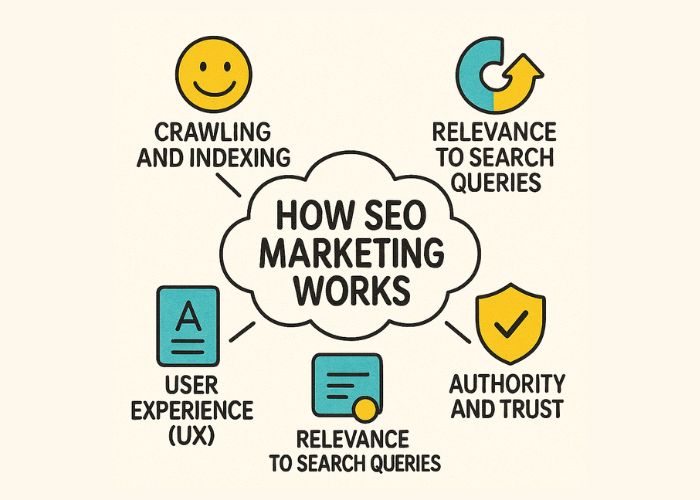
SEO marketing works by aligning your website with the way search engines crawl, index, and rank content on the web. Search engines like Google use complex algorithms (sets of rules) to evaluate webpages and decide which ones to show for a given query. While these algorithms are proprietary and ever-changing, SEO experts have identified key ranking factors over time. Here’s how SEO works:
-
Crawling and Indexing: Search engines constantly crawl the internet using automated programs called bots or spiders that follow links and read webpages. The content they find is then indexed . If your site isn’t easily crawlable (due to missing links, broken code, lack of sitemap, etc.), it may not get indexed properly, meaning it won’t appear in search results. Part of SEO is making sure search engines can find and understand all your pages.
-
Relevance to Search Queries: When a user types a query, the search engine scans its index for pages that are relevant to the terms. It looks at factors like the words on your page (content and keywords) and how closely they match the search intent. For example, if someone searches “best coffee shop in Seattle,” the engine will look for pages about coffee shops in Seattle. SEO marketing ensures your content uses the keywords and topics your target users are searching for, in a natural and helpful way.
-
Authority and Trust: Search engines also evaluate how authoritative or credible a page/website is on the topic. One major factor here is backlinks – links from other websites to yours. Think of each backlink as a vote of confidence. If many reputable sites link to your page, search engines interpret it as a sign that your content is high-quality and trustworthy. (We’ll discuss backlinks more under off-page SEO.) Other trust signals include your site’s history, expertise, and the quality of information. SEO marketing involves building your site’s authority over time, for example by earning links and mentions from other sites.
-
User Experience (UX): Modern SEO is not just about appeasing algorithms – it’s also about delivering a great experience to users who visit your site. Search engines favor sites that load quickly, are mobile-friendly, have a clear structure, and keep visitors engaged. If people click your site and immediately “bounce” back to the results (perhaps because your page was slow or not what they expected), it can hurt your rankings. High-quality content and good UX work hand-in-hand in SEO. In fact, SEO marketing involves optimizing technical aspects and usability of your site so that visitors (and search bots) can navigate easily and find value.
In short, SEO marketing works by combining relevant content with website optimizations and credibility signals to satisfy both the search engine algorithms and user needs. When done right, SEO helps search engines crawl your content and determine how it should rank on SERPs. The result of effective SEO marketing is that your site appears prominently for searches related to your business, without you having to pay for each click.
Why Is SEO Important?
You might be wondering if SEO is worth the effort – especially if you’re new to it. The answer is a resounding yes. SEO is critically important for businesses and anyone with a website because search engines are one of the primary ways people discover content online. Here are a few reasons why SEO marketing matters:
-
Massive Search Audience: Search engines are the starting point for most online experiences. Every second, thousands of people are typing queries into Google, Bing, etc., seeking information or solutions. In fact, Google processes over 8.5 billion searches every day. That’s an almost unimaginably large audience. If even a tiny fraction of those searches are related to your niche, that’s a huge opportunity to attract visitors. SEO marketing helps you tap into this “free” traffic stream by making sure your site shows up when it’s relevant.
-
High Intent and Quality Traffic: The traffic that comes from SEO is often highly valuable because it’s targeted and intent-driven. Think about it – if someone searches “what is SEO marketing”, they actively want that information (and found this page as a result!). If someone searches “best running shoes for flat feet”, they are likely considering a purchase. By ranking for the right keywords, you attract visitors who are already interested in what you offer, whether it’s knowledge, products, or services. This often leads to higher engagement and conversion rates compared to many other marketing channels.
-
Cost-Effective & High ROI: SEO marketing can deliver an excellent return on investment. While it takes effort (and sometimes money if you hire help or buy tools), the traffic itself is free. Once your pages rank well, you’ll keep getting clicks without paying for each visit. Consider this statistic: for every dollar spent on SEO, businesses earn an average of over $22 in return. That’s a 2200% ROI on average, which outperforms many traditional advertising methods. Moreover, the benefits of SEO are long-term – a well-optimized site can keep attracting traffic for years. In contrast, paid ads stop showing the moment your budget runs out.
-
Builds Credibility and Brand Awareness: Ranking at the top of search results not only drives traffic but also builds trust with your audience. Users tend to trust Google’s judgment – if your site appears on page one, it’s like an endorsement that your content is relevant and authoritative. Over time, this increases brand visibility and credibility. Even if a searcher doesn’t click your site the first time, seeing your name frequently for topics can imprint your brand in their mind (a form of brand awareness).
-
Competitive Advantage: If you’re not doing SEO, you can bet your competitors are. Failing to optimize means losing ground to competing websites that will siphon away your potential visitors. On the other hand, a strong SEO marketing strategy helps you stay ahead of competitors in the search rankings. For example, if you run a local bakery and optimize your site for “best bakery in [Your City]” while others don’t, you stand a much better chance of being the bakery that hungry locals find first. In many cases, SEO can be a deciding factor in whether a customer finds you or someone else.
-
Supports Other Marketing Efforts: SEO doesn’t operate in a vacuum – it complements other marketing strategies. Great content created for SEO can be repurposed for social media or email marketing. The insights you gain from keyword research can inform your overall content and marketing strategy. Additionally, having a solid SEO foundation (fast site, good content) will improve the performance of any paid ads you do, since your landing pages will be more relevant and user-friendly.
In summary, SEO marketing is important because it connects you with a huge audience actively looking for what you offer, at a cost that can be far lower than other channels, while building long-term authority for your brand. As the American Marketing Association puts it, SEO is “a game changer you can’t afford to ignore”. By investing a bit of time to understand and implement SEO basics, you set your website up for sustainable success.
Key Types of SEO Marketing
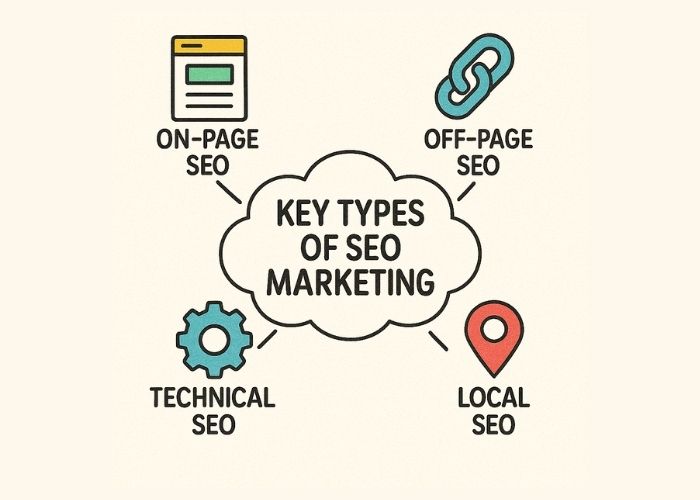
SEO marketing isn’t a single thing you do – it’s a combination of different practices. Generally, we can break SEO down into a few main types or categories. Each addresses a different aspect of how your site performs in search. The primary types of SEO are on-page SEO, off-page SEO, technical SEO, and local SEO. Let’s explore each one:
On-Page SEO (Optimizing Your Website Content)
On-page SEO involves optimizing the elements on your website – the content and HTML source code of a page – to make it search-engine-friendly and valuable to readers. It’s the largest bucket of SEO activities you’ll work on. The goal of on-page SEO is to help search engines understand the content of your pages and determine that it’s relevant and high-quality, so they rank it higher.
Key aspects of on-page SEO include:
-
Quality Content and Keywords: Content is king in SEO. Every page on your site should have original, useful, and relevant content that meets the needs of your visitors. Part of this is doing keyword research to find out what terms people use to search in your niche (e.g., “how to train a puppy,” “best budget smartphone 2025”) and then incorporating those keywords naturally into your content. Search engines analyze your page text to gauge how closely it matches the searcher’s intent. By covering your topic in-depth and including related terms, you increase topic relevance.
-
Title Tags and Meta Descriptions: These are part of your page’s metadata (information in the HTML that isn’t directly visible on the page itself, but is read by search engines and displayed in search results). The title tag is like the headline that appears on the search results page, and the meta description is the snippet of summary below it. Optimizing these is crucial: include your primary keyword and write them to be compelling to users. A good title tag can improve click-through rate (CTR) – the percentage of people who see your page in results and actually click it. (You may have noticed the title and meta description of this article in Google before clicking it!)
-
Heading Tags and Content Structure: Using headings (H1, H2, H3, etc.) and subheadings to structure your content makes it easier for both readers and search engines to navigate. In this article, for example, each major section has a clear heading. Search engines use headings to understand the hierarchy of information on a page. Also, breaking content into smaller paragraphs, bullet points, or lists (like we’re doing now) improves readability – a positive signal for SEO as it leads to better user engagement.
-
Internal Linking: This is the practice of linking to other relevant pages on your own site. For instance, if you have a blog post about “10 Healthy Recipes” and another about “Nutrition Tips,” linking them helps users find related content and helps search engines understand the relationship between your pages. Internal links also distribute “link equity” (ranking power) throughout your site, which can help pages get indexed and ranked. As a beginner, make a habit of linking to your other articles or pages when it makes sense (like we will link to our own SEO tool later in this guide).
-
Image Optimization: Images should also be optimized on-page. This means giving them descriptive file names (e.g.,
fresh-baked-cookies.jpginstead ofIMG1234.jpg), compressing them so they don’t slow down your site, and adding alt text. Alt text is a short description of the image for accessibility and for search engines (since search bots can’t “see” images). Including your keywords or related terms in alt text (where relevant) can slightly boost SEO and will certainly help visually impaired users understand your content. (All images in this article have alt text describing them, including the keyphrase “SEO marketing”.) -
URL Structure: Search engines and users both read your URLs. A clean, keyword-rich URL can improve SEO. For example,
yourwebsite.com/what-is-seo-marketingis preferable toyourwebsite.com/index.php?id=123. It’s short, descriptive, and includes keywords. Ensure each page’s URL slug (the part after the domain) reflects the content. This is often done automatically by CMS platforms, but you can usually edit it. Keep URLs lowercase and use hyphens to separate words.
On-page SEO is largely under your control – you have the power to edit your content and site elements directly, which is why it’s often the first place to start with SEO marketing. By following on-page best practices (relevant content, proper use of keywords, good formatting, etc.), you make it easy for search engines to grasp what your page is about and to consider it a valuable result to show users.
Off-Page SEO (Building Authority Beyond Your Site)
Off-page SEO refers to actions taken outside of your own website that impact your rankings. The central focus of off-page SEO is building your site’s authority, credibility, and trustworthiness in the eyes of search engines. The main way this is accomplished is through backlinks – links from other websites pointing to yours.
Think of backlinks as “votes of confidence” from the rest of the internet. If many quality sites link to yours, search engines assume your content must be valuable or important. Not all links are equal, though. One link from a highly respected, high-traffic site (say, a news outlet or Wikipedia) can be far more impactful than 100 links from low-quality or spammy sites. Here are key elements of off-page SEO:
-
Link Building: Earning and creating backlinks is at the heart of off-page SEO. Some ways to get backlinks include:
-
Creating excellent content that people naturally want to reference and share (often called “linkbait” if it’s especially compelling).
-
Reaching out to other website owners or bloggers with a piece of your content that their audience might find useful, in hopes they will link to it.
-
Guest blogging on other websites (writing an article for them) that includes a link back to your site.
-
Listing your business in directories or industry listings (ensure they are reputable).
-
Being mentioned in news articles, press releases, or case studies.
The key is earning links in a legitimate way – avoid old-school manipulative tactics like buying links or participating in link farms, as search engines are very savvy at detecting unnatural linking and can penalize your site.
-
-
Social Signals and Mentions: While links are the primary off-page factor, general mentions of your brand or website across the web can also help. If people are talking about your brand on social media, forums, or Q&A sites (even if those are nofollow links or just plain text mentions), it can indirectly contribute to your credibility and drive traffic that leads to more links. Engaging with communities and building a social media presence won’t directly boost your Google ranking, but it can amplify your content’s reach and lead to more linking opportunities.
-
Domain Authority: Over time, as you accumulate quality backlinks and positive mentions, your website develops a stronger domain authority (a term SEO professionals use to gauge a site’s overall strength or reputation). Sites like Moz and Ahrefs even provide a “domain authority” or “domain rating” score (from 0-100) based on backlink profiles. A higher authority site will generally find it easier to rank for content than a brand new or low-authority site. This is why off-page SEO is a bit of a long game – you are essentially investing in your site’s reputation. As your authority grows, every new page you optimize has a better chance to rank. Think of it like building credit; a good credit history makes future loans easier to get.
It’s worth noting that off-page SEO can be the most challenging for beginners, because you have less direct control. However, a smart strategy is to focus on on-page SEO and content first – when you publish great content, you increase the likelihood that others will link to it naturally.
You can then lightly promote it (share on social media, send to a friend or two in the industry) to kickstart the process. Remember, quality over quantity is the rule for links. A few links from trusted sites are better than dozens from unknown websites. As Google’s original PageRank algorithm was based on the idea that good content gets linked, off-page SEO remains a crucial part of SEO marketing. Over time, a strong backlink profile will significantly boost your search rankings.
Technical SEO (Under-the-Hood Optimizations)
Technical SEO involves improving the behind-the-scenes aspects of your site to help search engines crawl and index your content more effectively, and to enhance user experience. It’s called “technical” because it deals with your site’s infrastructure and code rather than page content. Even if you’re not a developer, you can still understand the basics of technical SEO and ensure your website software or platform is configured properly. Key elements include:
-
Site Speed: A fast-loading website is crucial. Both users and search engines hate slow pages. If your site takes too long to load, visitors may abandon it (increasing bounce rate, which is bad for SEO), and Google has stated that site speed is a ranking factor. Optimize images (compress them), enable browser caching, use fast hosting, and minimize bulky code or scripts. For beginners, using a tool like Google PageSpeed Insights or GTmetrix can help identify speed issues. Many site builders and CMSs have plugins or settings to help with caching and minifying code. Technical SEO ensures your site speed is up to par for a smooth experience.
-
Mobile-Friendliness: More than half of all web traffic comes from mobile devices. Google now predominantly uses mobile-first indexing, meaning it considers the mobile version of your site as the primary version. If your site isn’t mobile-friendly (e.g., not responsive, content doesn’t fit smaller screens, links/buttons are too small to tap), it will hurt your SEO. Most modern website themes are mobile-responsive by default, but always test your site on a phone or use Small SEO Tools. Technical SEO involves making sure your site looks and works great on mobile devices.
-
Site Structure and Navigation: A clear site architecture helps search bots crawl your site and helps users find what they need. Ensure that your site has a logical structure – for example, main pages linked from a menu, categories grouping related content, etc. Using a XML sitemap (a file listing all important pages on your site) and a proper robots.txt file (which tells search engines which pages they can or cannot crawl) are part of technical SEO. Most beginners don’t need to hand-code these – plugins or built-in SEO tools can generate a sitemap for you. Submitting your sitemap to Google Search Console is a good practice to ensure Google knows about all your pages.
-
Indexing and Crawl Errors: Sometimes pages might not get indexed due to errors. Using Google Search Console (a free service from Google for site owners) will alert you to issues like broken pages (404 errors), pages that are blocked from crawling, or other indexing problems. Part of technical SEO is regularly checking for and fixing these errors. For instance, if you delete a page, set up a redirect to a relevant page instead of leaving a dead link. This maintenance keeps your site healthy in the eyes of search engines.
-
Structured Data (Schema Markup): This is a more advanced aspect, but worth mentioning. Structured data is code (often in JSON-LD format) that you add to your pages to help search engines understand the context of your content. It can enable special rich results. For example, a recipe page with schema might show up in Google with star ratings, cook time, and calorie information right in the results snippet. For a beginner, adding schema isn’t mandatory, but if you run something like an e-commerce site or a blog, using schema for products, reviews, articles, etc., can give you an extra SEO edge by enhancing how your listing appears. Many CMS platforms have plugins to add basic schema without coding.
In short, technical SEO is about eliminating any technical barriers to your site’s success in search. You want search engine crawlers to easily access and understand your content, and you want users to have a seamless, secure experience. It’s worth noting that technical SEO also includes ensuring your site is secure (using HTTPS encryption). If your URL still begins with http:// and not https://, obtaining an SSL certificate is critical, as browsers and Google flag non-HTTPS sites as not secure.
For most beginners, choosing a reliable website platform (like WordPress, Shopify, etc.) and using an SEO plugin or built-in SEO settings will cover a lot of technical SEO basics. But it’s good to be aware of these concepts so you can troubleshoot if something goes awry. A well-structured, fast, and functional site creates a strong foundation for all your other SEO marketing efforts
Local SEO (Reaching Local Customers)
Local SEO is a specialized branch of SEO marketing aimed at improving your visibility in local search results. If you operate a business that serves a specific geographic area (like a local store, restaurant, service provider, or any “brick-and-mortar” business), local SEO is incredibly important. It helps you show up for searches that have local intent, such as “coffee shop near me” or “best plumber in [Town Name]”. Even if you don’t have a physical storefront, if you target customers in particular locations (like a city or region), local SEO techniques can help those people find you.
Key components of local SEO include:
-
Google Business Profile (Google My Business): Claiming and optimizing your Google Business Profile is the cornerstone of local SEO. This is the listing that appears in Google’s local pack/maps and includes your business name, address, phone number, website, hours, and reviews. It’s free to create. Ensure your information is accurate and complete. Add photos, respond to reviews, and regularly update posts or offers. Coursera’s SEO guide notes that completing a Google Business Profile can boost your local SEO results. Indeed, a well-maintained profile can be the difference between appearing in the local 3-pack (the map results) or not.
-
NAP Consistency: NAP stands for Name, Address, Phone number. Ensure that your business’s NAP is consistent everywhere it appears on the web – your site, your Google profile, Yelp, Yellow Pages, Facebook, etc. Inconsistencies (like one site saying “Street” and another “St.” or old phone numbers) can confuse search engines and users. Consistent NAP information signals reliability. You should list your NAP prominently on your website (often in the footer or contact page).
-
Local Keywords and Content: Incorporate local terms in your site’s content where appropriate. For example, if you’re a dentist in Denver, your homepage and about page should mention Denver naturally in the copy (e.g., “proudly serving the Denver community”). You might create blog posts or pages that are location-specific (like “How to Choose a Dentist in Denver: 5 Tips”). Additionally, consider creating location-specific landing pages if you serve multiple areas, each optimized for queries in those areas. This way, someone searching “[Your Service] in [Neighborhood/City]” can find a dedicated page.
-
Online Directories and Citations: Aside from Google’s own listings, getting listed on other reputable online directories can help local SEO. Examples include Yelp, TripAdvisor, Bing Places, Apple Maps, Angie’s List, and industry-specific directories. Many of these sites rank well for local searches and can send traffic your way, and they also often provide a backlink or mention of your site (a citation). Just be sure to keep your information consistent, as mentioned. There are services and tools that can help manage multiple listings from one place.
-
Reviews and Ratings: Customer reviews are a big part of local SEO. Positive reviews on your Google Business Profile (and other platforms like Yelp or Facebook) can improve your visibility and click-through rate. Encourage happy customers to leave reviews. Respond to reviews politely and professionally, even negative ones – engagement shows that you value customers. Search engines likely consider overall review sentiment and volume as factors for local rankings (as an indirect quality signal). Plus, when potential customers see strong ratings, they’re more likely to choose your business.
-
Local Structured Data: If you have a physical business location, you can use LocalBusiness schema markup on your website to give search engines clear information about your company (like address, hours, coordinates, etc.). This can sometimes help enhance your search listings (for instance, showing your star rating or hours directly in the snippet).
Local SEO strategies aim to get you in front of customers in your vicinity at the exact moment they’re searching for what you offer. Think of the last time you were looking for a quick service – maybe “pizza delivery” or “car repair near me.” The businesses optimized for local SEO are the ones you likely saw first. As a beginner, if local traffic is relevant to you, focus on getting your Google Business Profile set up and gathering some reviews. That alone will put you ahead of many competitors. And remember to link to your website from your profile – local SEO and traditional SEO go hand-in-hand (your website still needs good on-page and technical SEO for maximum effect locally).
Now that we’ve covered the main types of SEO (on-page, off-page, technical, and local), you might be thinking: “This is a lot! How do I actually start doing SEO marketing?” Don’t worry – next we’ll break down some beginner-friendly steps and tips to help you implement SEO for your own website.
How to Get Started with SEO Marketing (Tips for Beginners)
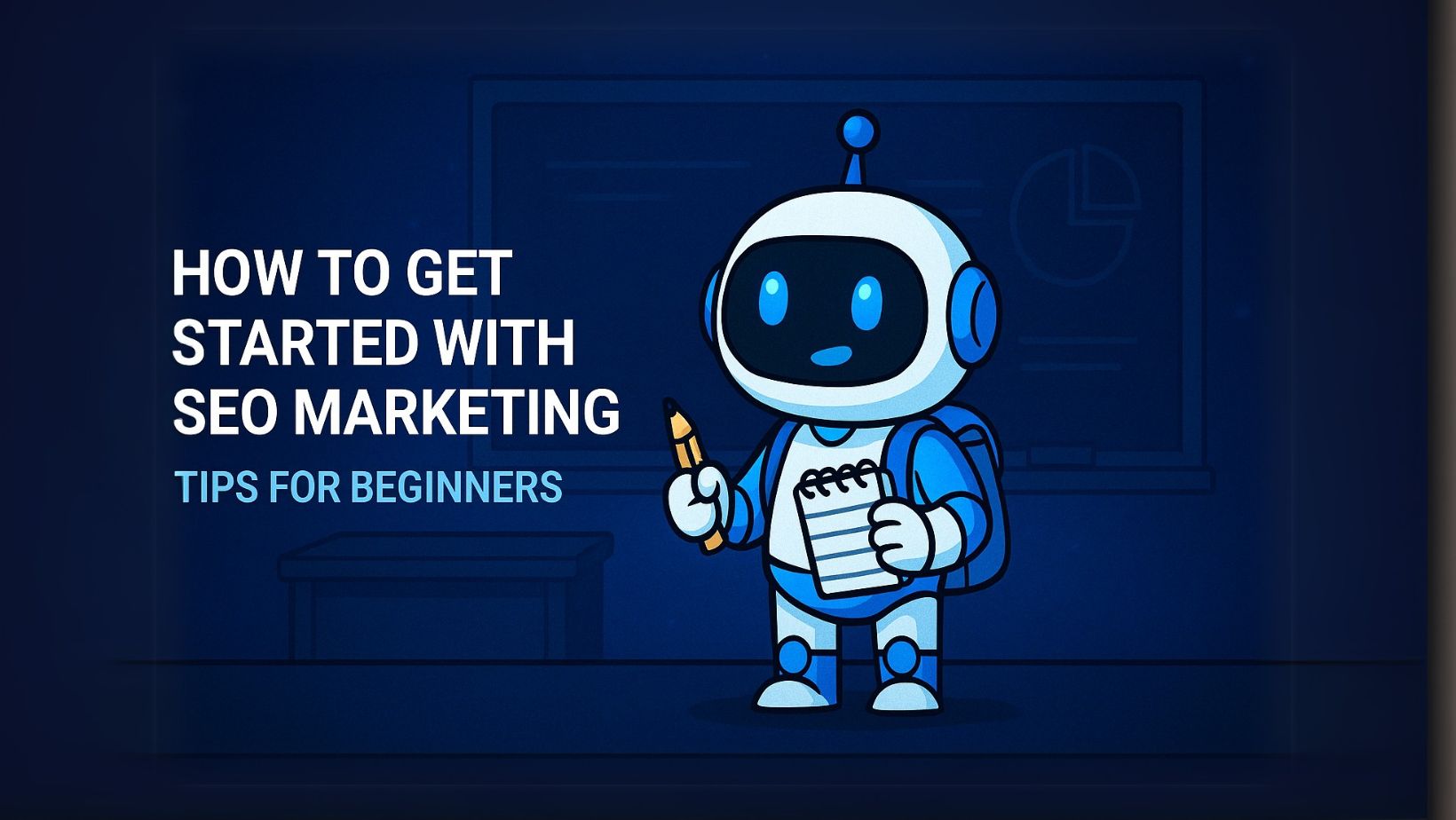
Getting started with SEO marketing can seem overwhelming, but you can begin with a few simple steps. Here’s a breakdown of practical tips and examples that beginners can implement right away:
-
Do Basic Keyword Research: Keywords are the search terms people type into Google. Understanding which keywords your target audience uses is foundational. Start by brainstorming a list of topics related to your business or site. Then use free tools to expand that list. For example, try typing a keyword into Google and see the autocomplete suggestions and the “People also ask” or “Related searches” sections – these give insight into popular queries. You can also use a free tool like Google Keyword Planner (you’ll need a Google Ads account, but you don’t have to run ads) or a freemium tool like Ubersuggest or AnswerThePublic. As a beginner, focus on finding long-tail keywords – longer, more specific phrases (e.g., “how to train a puppy not to bite” instead of just “puppy training”). Long-tail terms often have lower search volume but also less competition, making them easier to rank for. Make a list of a few primary keywords and related variations you want to target with your content.
-
Optimize Your Page Titles and Meta Descriptions: For each important page or post on your site, ensure the SEO title (title tag) includes your main keyword and clearly describes what the page is about. Keep it around 50–60 characters so it doesn’t get cut off in results. Similarly, craft a meta description (~150–160 characters) that includes the keyphrase and a compelling summary or call-to-action. For instance, if you have a blog post about Italian cooking tips, an optimized title could be “10 Italian Cooking Tips for Beginners – Master Pasta and Sauce” and a meta description might be “Learn what is SEO marketing for Italian cuisine lovers – oh wait, wrong example! – Learn 10 essential Italian cooking tips to improve your pasta, sauces, and more. Authentic advice for beginners to cook like a pro.” (Okay, that meta is a bit long-winded, but you get the idea: make it informative and enticing.) An optimized title and description help search engines understand your content and can dramatically increase the chances of a user clicking your result over others.
-
Create Quality, People-First Content: This tip cannot be overstated. Google’s algorithms have evolved to heavily favor content that is helpful, thorough, and user-centric. Whatever topic you’re covering, aim to provide genuine value. Write in a clear, readable way. Use examples, answer common questions, and avoid fluff. A good practice is to search for the keyword yourself and see what the top-ranking pages are doing – then ask, “How can I make something even better or more useful?” For example, if you’re writing “what is SEO marketing,” you’d ensure you cover definition, types, examples, etc. (just like this guide does). Also, keep content up to date; information can become outdated quickly, and fresh content tends to rank better for certain queries. Remember to naturally incorporate your target keywords in the content, especially in the first paragraph or two (so both users and search engines quickly see that the page is relevant). But don’t keyword-stuff – use variations and make sure everything reads smoothly. If you ever find yourself writing for the search engine at the expense of the reader, take a step back. It’s about balance.
-
Improve Your Site’s User Experience: A beginner can do a lot to improve UX without advanced skills. Choose a clean, mobile-responsive design or theme for your site. Organize your navigation menu logically so users can find information easily. Use headings, bullet points, and images to break up text. Ensure any important info (like your contact details or product categories) is easy to find. Also, check your site on a smartphone to see that everything works and looks right (buttons not too small, no off-screen text, etc.). User-friendly sites tend to have lower bounce rates and higher engagement, which can indirectly boost SEO. Google pays attention to signals like how long visitors stay on your page (dwell time) and whether they quickly return to search results – these can imply satisfaction or dissatisfaction with your content.
-
Set Up Google Search Console and Analytics: These free tools from Google are extremely useful for SEO. Google Search Console allows you to submit your sitemap, see which queries your site is appearing for, monitor your average position, and get alerted to any crawl errors or security issues. It’s like a direct line of communication with Google about your site’s health in search. Google Analytics lets you track your site’s traffic and user behavior. As an SEO beginner, you might not use all the advanced features, but at minimum you can see how much organic traffic you’re getting and which pages are most popular. Over time, this data helps you measure if your SEO efforts are paying off (e.g., organic visitors increasing, certain blog posts getting search hits, etc.). Both tools have guided setups – typically involving adding a small verification code to your site (or using a plugin to do so).
-
Build Some Backlinks (Ethically): Especially if you’re starting a new site, your “authority” in Google’s eyes might be low. To improve this, look for opportunities to get your site linked elsewhere. A few starter ideas:
-
Share your new blog posts or pages on your social media profiles. While those links might not directly boost SEO (most social links are “nofollow”), they can bring initial visitors who might share it further.
-
If you mention any influencers or companies in your content, let them know – they might share your article with their audience or even link to it.
-
Submit your site to relevant directories or local listings (for example, if you’re a local business, ensure you’re on Google Maps, Yelp, Bing Places, etc. – as mentioned in local SEO). Some of these provide links.
-
Consider writing a guest article for another site in your industry. Many websites accept guest contributions and allow an “author bio” or context link back to your site. Just make sure the site is reputable and the content you provide is high quality.
-
Engage in communities (like forums or Q&A sites such as Quora or Stack Exchange) where providing a link to your content is appropriate and helpful to answer someone’s question. (Don’t spam links – only share when it’s genuinely adding value.)
Early on, even a handful of decent backlinks can start to make a difference. Off-page SEO takes time, so be patient and let links grow naturally as you keep creating content.
-
-
Monitor Your Progress and Be Patient: SEO results do not happen overnight. It often takes a few months for a new site or new content to gain traction in search engines. Use Search Console to see if your pages are getting impressions (views in search results) for your target keywords. If after a while some pages aren’t performing, revisit them – maybe you need to update the content, target a less competitive keyword, or get a few more backlinks to it. SEO is iterative. Also, keep learning – the SEO landscape can change as algorithms update. Following authoritative SEO blogs or communities can help you stay updated on best practices.
By implementing these steps, you’ll be well on your way. For example, let’s say you run a small baking blog. Your steps might be:
-
Researching keywords like “easy cake recipes” or “gluten-free baking tips”.
-
Writing a detailed post “5 Easy Cake Recipes for Beginners” with those keywords in mind, making sure to include great recipes (content quality) and descriptive images (with alt text like “Chocolate cake – easy recipe SEO marketing example”).
-
Ensuring the page title and meta description mention “easy cake recipes for beginners”.
-
Sharing the post on your Facebook and Instagram, and maybe on a baking subreddit for feedback.
-
Over the next few weeks, checking Search Console to see if you start ranking for any long-tail variations of “easy cake recipes”. Perhaps you notice people finding you for “simple birthday cake for beginner bakers” – you could then even optimize or create content around that.
The key is to start small, be consistent, and keep the user’s experience and intent at the forefront. SEO marketing is a marathon, not a sprint – but every improvement you make can lead to a steady increase in traffic and visibility.
Common SEO Marketing Myths Debunked
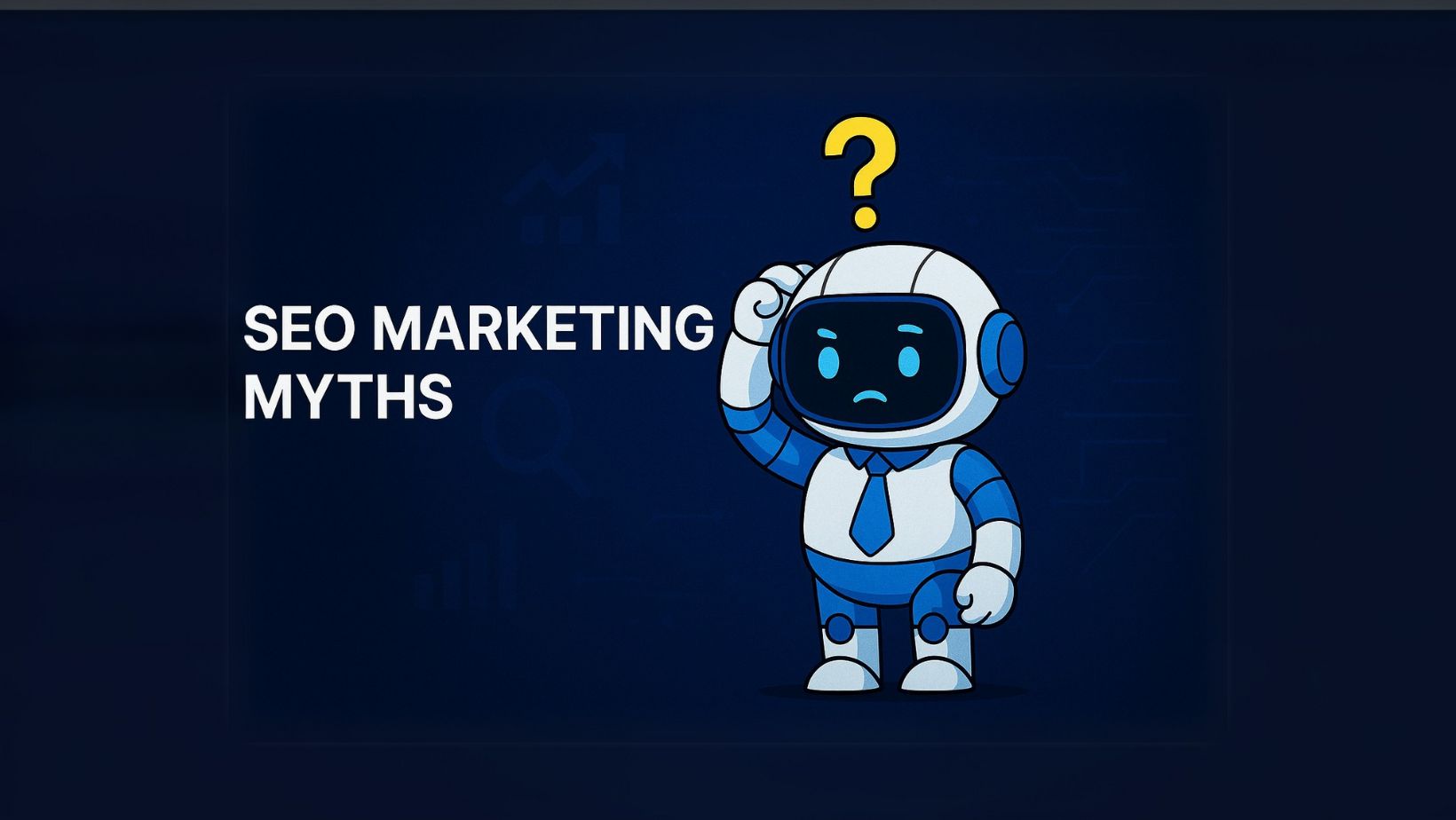
As you learn about SEO, you might encounter some myths or misconceptions. It’s important to know fact from fiction so you don’t waste time on strategies that don’t work (or worse, harm your rankings). Here are some common SEO marketing myths – and the truth behind them:
-
Myth: “SEO is a one-time task.”
Truth: SEO is an ongoing process, not a set-it-and-forget-it deal. You can’t just optimize your site once and expect to rank forever. Competitors will be publishing new content, search trends will evolve, and search engines will update their algorithms. Effective SEO marketing requires continuous effort – updating old pages, creating new content, refining your strategy, and keeping up with best practices. Think of it like staying fit; you can’t exercise for one week and then stop and expect to remain in top shape permanently. -
Myth: “The more keywords I cram in, the better.”
Truth: Keyword stuffing (overusing keywords in your content or meta tags) is an outdated and harmful tactic. In the early days of SEO, some sites would literally list keywords over and over or hide them in invisible text. Search engines now penalize this behavior because it leads to a bad user experience. Today, it’s about keyword placement and context, not sheer volume. A few strategic mentions of your keyword, especially in the title, headings, and first paragraph, plus semantic variations throughout, is sufficient. Always prioritize writing for humans. If you use a keyword excessively and the text reads awkwardly, dial it back. Modern search algorithms are smart enough to understand context and synonyms – they might even rank a well-written page for a keyword even if that exact phrase isn’t repeated too often, as long as the topic is covered comprehensively. -
Myth: “SEO is all about tricking Google.”
Truth: In the past, people tried to “game” the system with various tricks (buying links, cloaking content, etc.). But Google and other engines have become incredibly advanced. SEO is not about tricks or hacks – it’s about aligning with what search engines actually want: valuable, relevant content and a good user experience. Any shortcut that violates search guidelines (known as “black hat SEO”) might work temporarily, but is likely to get your site penalized or banned in the long run. Instead of trying to outsmart the algorithm with gimmicks, focus on playing by the rules and doing things the right way. The good news is, the “right way” and the “effective way” are now largely the same: serve your users well, and you’ll generally please the search engines too. -
Myth: “I need to pay for Google ads to rank in organic search.”
Truth: Organic rankings are not influenced by whether you purchase Google Ads. Google’s search and advertising departments are separate – paying for ads might increase your overall site traffic and visibility, but it does not directly boost your organic SEO ranking. Some people assume big companies rank #1 because they spend a lot on ads; in reality, they rank because they have strong SEO (often lots of content and backlinks) and they might also run ads. You can certainly rank #1 organically without spending a dime on advertising (many blogs and Wikipedia pages do). However, one area of slight crossover: if you run ads, you might discover which keywords convert well, and then decide to target those in SEO, but the act of paying Google for ads won’t buy you any favors in the unpaid results. -
Myth: “SEO is dead” (or “Just focus on social media instead”).
Truth: SEO is very much alive and constantly evolving. Sometimes you’ll hear “SEO is dead” typically after a big algorithm update or when new platforms (like voice search or TikTok) emerge. It’s true that the way SEO is done has changed (for example, stuffing meta keywords tag doesn’t work, Flash websites are obsolete, etc.), but the core goal of SEO – improving visibility in search – is still critical. In fact, as of now, organic search drives a huge portion of web traffic (over 50% for many sites). Social media and other marketing channels are important too, but they haven’t replaced search. Think of how you use the internet – chances are, you still use Google (or another engine) multiple times a day. As long as people use search engines, SEO marketing will matter. It’s not dead; it’s just matured. -
Myth: “Ranking #1 is the only goal.”
Truth: While everyone dreams of that #1 spot, SEO marketing is about improving overall organic visibility and traffic – not just a single ranking. Sometimes being #3 or #5 for a high-volume query will bring more traffic than being #1 for a very niche query. It’s also about quality traffic: you want visitors who actually engage with your site or convert into customers, not just anyone who accidentally stumbles upon you. Moreover, modern search results have many features (maps, featured snippets, “people also ask” boxes, etc.). So success might also mean appearing in a featured snippet or getting your image shown, not purely the blue link rankings. Set practical SEO goals: e.g., increase organic traffic by X%, get Y more sign-ups from organic per month, improve the number of keywords you rank in the top 10 for, etc. Don’t be discouraged if you’re not #1 for everything – focus on building overall momentum and presence.
By understanding the truth behind these myths, you can avoid common pitfalls. SEO marketing does require patience and effort, but it’s not magic or trickery – and it certainly isn’t futile. It works when done correctly. Keep these realities in mind as you continue optimizing your site.
Useful SEO Marketing Tools for Beginners
As a beginner venturing into SEO, you’ll be glad to know there are many tools (most of them free or with free tiers) that can make the job easier. These tools can help with keyword research, site analysis, and tracking your performance. Here are some essential SEO marketing tools and software to consider:
-
Google Analytics (Free): As mentioned, this is the go-to tool for monitoring your website traffic. It helps you see how many people are visiting, where they come from (organic search vs. other channels), which pages are most popular, and more. It’s invaluable for measuring the impact of your SEO efforts over time. If you’re new to it, Google has free courses (Google Analytics Academy) that can teach you the basics.
-
Google Search Console (Free): Another must-have from Google. It shows you the search queries that led people to your site, how your pages rank for those queries, and your click-through rates. It also flags technical issues. For example, if Google has trouble indexing some content, you’ll see crawl errors here. You can also fetch and render pages to see how Googlebot views your site. It’s an SEO diagnostic and feedback tool all in one.
-
SEO Browser Extensions (Free): There are handy browser add-ons that give quick SEO insights as you surf the web. For instance, MozBar (by Moz) and SEOquake provide on-page SEO info at a glance, such as the page title, meta description, headings, and they can even show metrics like the page’s authority or number of backlinks. Keyword Surfer (a Chrome extension) shows estimated search volumes for queries right in your Google search results, which is great for quick keyword brainstorming. These tools help you study both your site and competitors’ sites easily.
-
Keyword Research Tools: Apart from Google Keyword Planner (which we mentioned and is free), you might try:
-
Ubersuggest: It offers keyword ideas, search volume, and SEO difficulty for free (with some limits per day).
-
AnswerThePublic: Visualizes questions people ask about a topic – great for content ideas.
-
SEMrush or Ahrefs: These are premium tools, but they often have free trials or limited free features. They provide comprehensive keyword research, competitive analysis, and more. For example, with a free SEMrush account you can get a few ideas or see limited data; the paid version is more robust, but not necessary for starting out.
-
Google Trends: Free and useful to see the popularity of a search term over time and compare keywords.
-
-
On-Page SEO Helpers: If you’re using a content management system like WordPress, consider installing an SEO plugin such as Yoast SEO or Rank Math. These plugins guide you when writing content – they let you set a focus keyword and will check if you’ve used it in your title, meta description, headings, etc. They also generate sitemaps and handle a lot of technical SEO optimizations (like meta tags). They’re beginner-friendly, giving a red/yellow/green light type score for your content’s SEO-friendliness. Just remember, the plugin’s suggestions are a guide, not absolute rules; you should use your own judgment too.
-
Site Audit Tools: To check the technical health of your site (like broken links, missing tags, slow pages), you can use tools like Google Lighthouse (built into Chrome DevTools, under “Lighthouse” or “Core Web Vitals”), or free crawling tools like Screaming Frog SEO Spider (free for small sites up to 500 URLs). These can uncover issues to fix. Additionally, our own SEO X-Ray tool can provide a detailed audit of your website’s SEO issues and performance. It’s like putting your site under a microscope to see what’s hurting your rankings and what to improve.
-
High Level’s SEO X-Ray Tool (Free Audit): We offer an internal tool – the SEO X-Ray Report – which gives you a comprehensive SEO audit of your site. It’s designed for beginners and pros alike to easily identify what’s working and what’s not. You’ll get insights on everything from site speed, mobile usability, to on-page SEO factors and backlink analysis. It’s a great starting point to understand your website’s SEO health. You can access a free SEO audit through our SEO audit services page – just enter your website, and you’ll receive a report highlighting the issues and opportunities. Consider it a roadmap for your SEO improvements, personalized to your site. (This doubles as an internal link example: notice how we linked to our own SEO tool page, which is good for our site’s internal linking structure!)
-
Rank Tracking Tools: As you optimize, you might want to keep track of where your pages rank for target keywords. Some free options include WhatsMySERP (limited free checks) or SERPWatcher (by Mangools, free trial available). However, you can also manually monitor a few important terms by simply searching for them (using an incognito window to avoid personalization) – but use tools if you want to track many keywords over time.
These tools will assist you at various stages: research, implementation, and monitoring. Many of them are either free or have free versions sufficient for a beginner. As you progress and perhaps manage larger sites or multiple projects, you might invest in paid SEO tools for deeper analysis. But initially, make the most of the free resources at your disposal.
Embrace SEO Marketing and Start Growing Your Traffic
By now, you should have a solid understanding of what SEO marketing is and why it’s so important for your online success. We covered the definition of SEO marketing, how it works, the different types (on-page, off-page, technical, local), and a slew of beginner-friendly tips to get you going. Remember, SEO marketing is a journey – even spending just 15 minutes a day implementing some of these practices can, over time, yield significant improvements in your website’s visibility.
As a beginner, focus on the fundamentals: create quality content that serves your audience’s needs, make your site technically sound and user-friendly, and start building your online reputation one link or mention at a time. Keep learning and adapting, because the world of search is always evolving. If you stay committed, you’ll likely start seeing more organic traffic trickling in, and nothing is more rewarding than noticing your site climbing up the search results for keywords that matter to you!
Finally, don’t hesitate to leverage tools and services that can accelerate your progress. SEO might seem complex, but you don’t have to do it all alone or blindly. For a free comprehensive checkup of your site’s SEO, try our SEO X-Ray Audit – it will pinpoint exactly what to fix or improve. You can get your custom report on our website. Taking advantage of such an analysis can save you time and highlight quick wins.
Ready to take your SEO marketing to the next level?

Put what you’ve learned into action! Start by auditing your own site for SEO opportunities.
We invite you to use our SEO X-Ray Tool for a free SEO audit of your website. It will show you what’s working and what isn’t, so you can prioritize your next steps.
Improve your SEO marketing strategy today and watch as your search rankings and traffic begin to rise. Good luck, and happy optimizing!
Related Posts
